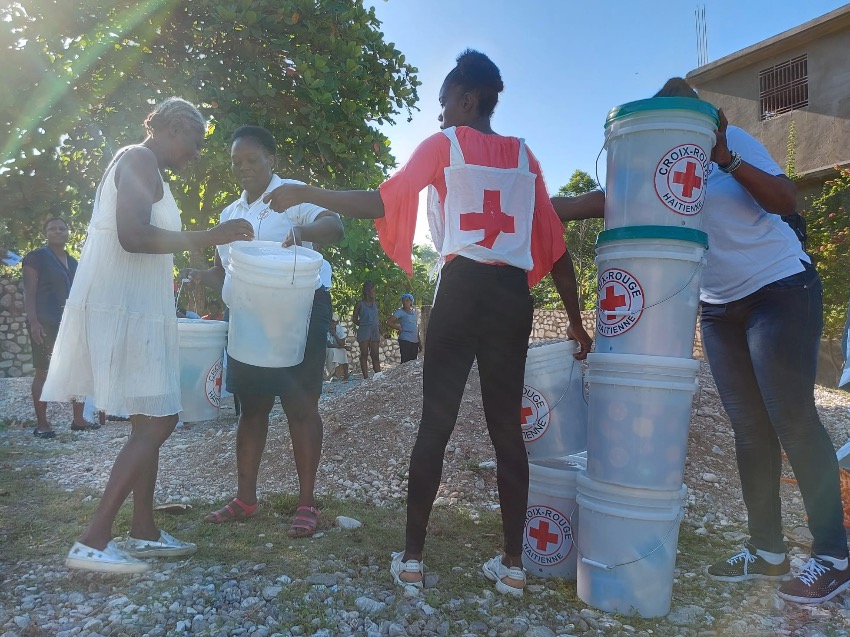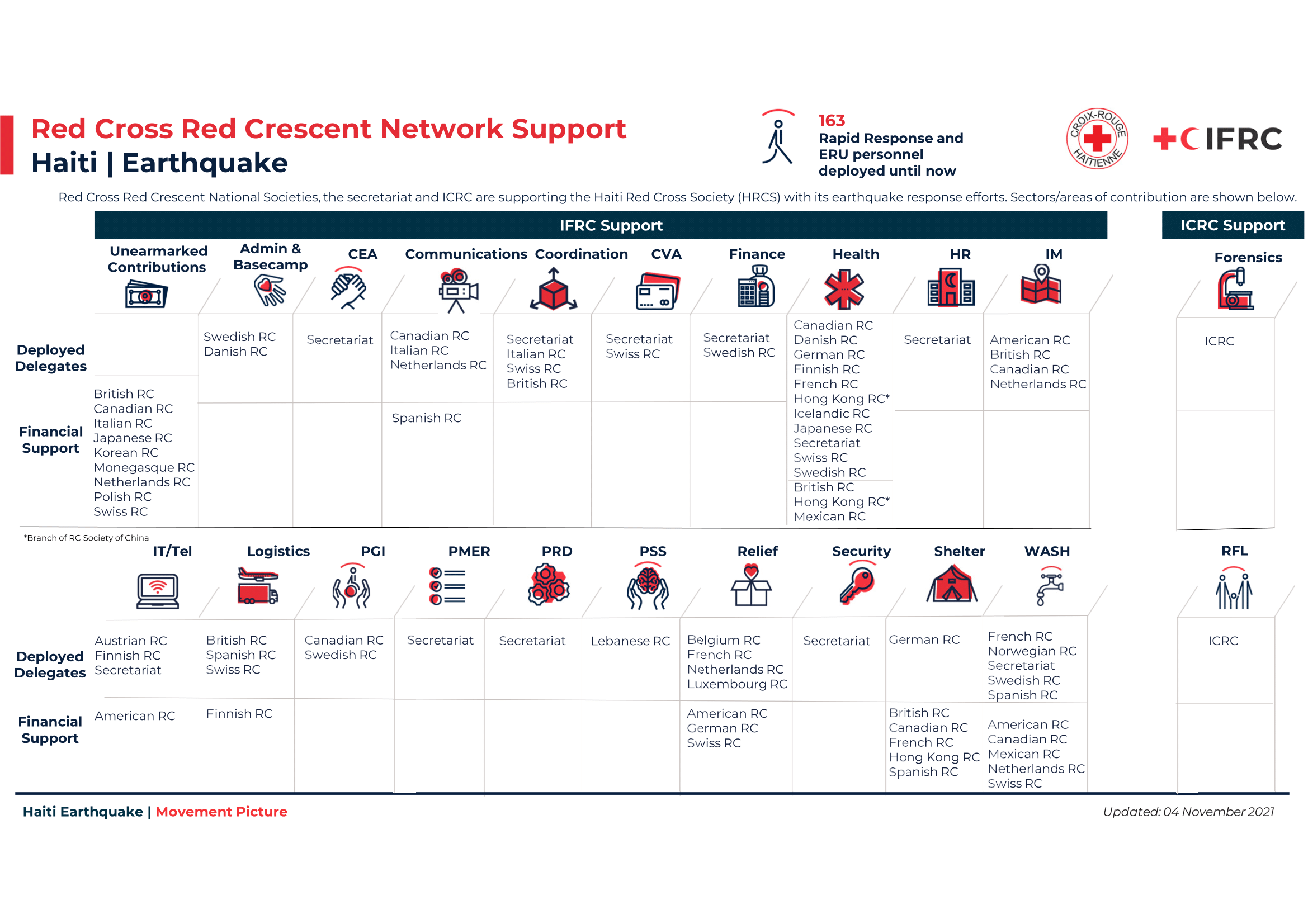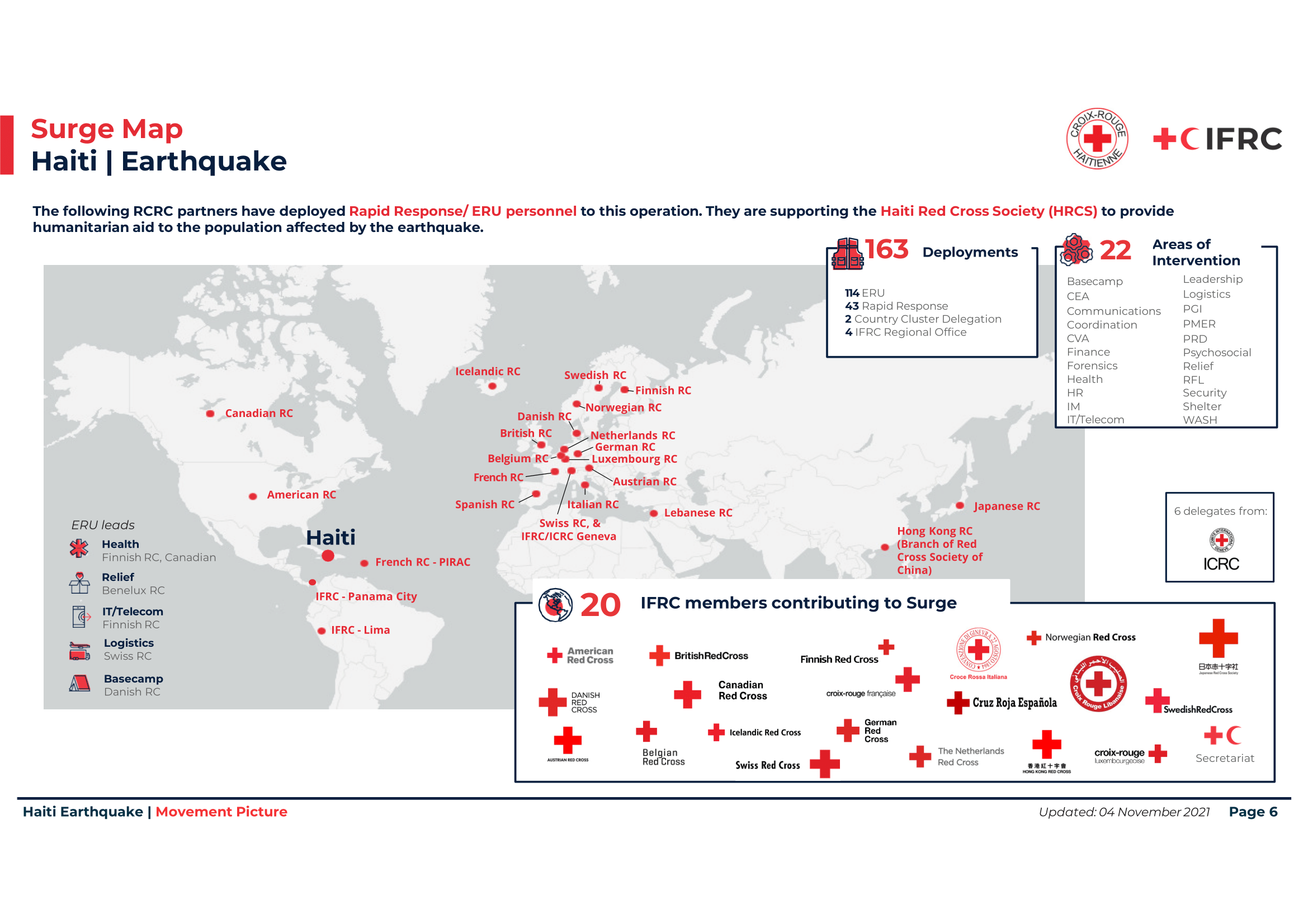Haiti earthquake: an example of an internationally coordinated response effort
On 14 August 2021, a 7.2 magnitude earthquake struck Haiti, causing more than 2,000 deaths and 13,000 injuries, and damaging, among others, houses, health facilities and schools. Three days later, Tropical Depression Grace made landfall in the country, resulting in flash and urban flooding. The consequences of the earthquake and flooding compounded by political instability, organised crime, food insecurity and COVID-19, exacerbated vulnerabilities, and hampered humanitarian efforts.
The Haiti Red Cross Society is leading multi-sectoral response efforts, facilitated by enhanced government-led coordination. As of October, Haiti Red Cross volunteers and staff had reached 8,207 families with water, food, and essential household items, 3,845 people with hygiene promotion activities, and 2,666 with healthcare. However, given the gravity of the situation, the Haiti Red Cross Society requested support for their activities to the International Federation of Red Cross and Red Crescent Societies (IFRC), sister National Societies, and the International Committee of the Red Cross (ICRC).

Yvan Trapet, Country Representative in Haiti from the Netherlands Red Cross, commented the need to adapt previous projects in the country to the emergency: “The Netherlands Red Cross has been providing support to the Haiti Red Cross Society on community resilience projects with mid- to long-term impacts, including ecosystem restoration. We systematically integrate aspects related to disaster preparedness and response so we can be reactive in our support in the event of a disaster. For instance, during the COVID-19 crisis, or following the 2021 earthquake, the Netherlands Red Cross responded by immediately mobilising funds, and human and logistical assistance, while working actively to secure additional resources specifically for emergencies to avoid impacting ongoing projects. Depending on the degree of emergency, it takes us between one and two weeks to put adapted mechanisms in place.”
In addition to mid- and long-term capacity building and community resilience projects, prepositioning of stocks is fundamental to promptly respond to a crisis. In Haiti, the American Red Cross and the French Red Cross PIRAC Platform – a network of National Societies from the Americas and the Caribbean that work together to respond to natural hazards and emergencies – were available with prepositioned stocks in the immediate aftermath of the earthquake. At the same time, the Haitian government and the Haiti Red Cross Society played a key role in coordinating a humanitarian corridor to allow movement of aid shipments.
Joël Cachera, Disaster Manager from the French Red Cross PIRAC Platform, shares the main challenges of being a first responder: “After a crisis of such magnitude, we quickly noticed that despite various preparedness plans carried out by the government and local humanitarian actors, structures were heavily impacted and not ready to organise the reception of humanitarian goods. Instead of being sent directly to the affected areas, non-food items had to therefore be sent to Port-au-Prince, the only port capable of receiving substantial stocks. This delayed distributions. The security challenges for deploying teams and humanitarian stocks are also difficult to grasp during the first days of a humanitarian response. This is why it is essential to establish a long-standing relationship of confidence with the sister National Society before any disaster strikes. In times of crisis and exacerbated stress, only a relationship based on trust and experience can permit us to understand each other and move forward effectively.”.
If a crisis occurs that overwhelms a National Society’s local ability to respond, the National Society can in addition request support from the IFRC’s global disaster response system. This includes surge services such as Emergency Response Units (ERUs) and rapid response personnel deployment, and finance mechanisms. Depending on the context and needs, different types of ERUs can be deployed by National Societies, under the coordination of the IFRC, for example emergency and health, water and sanitation (WASH), relief, logistics, and IT.

Ritva Lahti, the first rotation team leader of the Red Cross Emergency Hospital from the Finnish Red Cross, describes this mechanism: “ERUs are an IFRC rapid response tool which is well adapted to contexts where normal services have been disrupted or destroyed. It can be set up quickly and it is self-sustainable for up to four months. In addition to national staff, the only requirements are the land for the hospital, fresh water and fuel for the generator. In this challenging context, it took a while for the hospital to open with all available services, but we could overcome these challenges and make the hospital open to all in need. Just before my departure, the first baby was born in the hospital, and this is always an important milestone.”
Antonio Del Fiacco from the Italian Red Cross, deployed as IFRC field coordinator, describes his experience: “I arrived a few days after the earthquake. Our team immediately focused on emergency measures, WASH and shelter, especially in rural areas. Now that this has been secured, we concentrate our efforts on livelihoods and household rehabilitation, psycho-social support, and long-term recovery from the earthquake. My team was composed by Red Cross and Red Crescent staff from many different countries. This has been a precious asset in addressing daily challenges with different approaches and perspectives. We can have different working-styles, but we share a common goal, and we coordinate our efforts to support vulnerable people and reach the most remote communities.”

Financial support is fundamental in crisis response and recovery. In coordination with the Haiti Red Cross Society, the IFRC immediately allocated EUR 710,000 thanks to the Disaster Relief Emergency Fund (DREF) and other sister National Societies also provided financial support. In addition, a first Emergency Appeal of EUR 9.5 million was launched on 15 August 2021 (recently revised to EUR 18 million according to the evolution of the situation).
Two months after the devastating earthquake, humanitarian assistance began to reach those in need more effectively, facilitated by enhanced government-led coordination and efforts to negotiate increased humanitarian access into hard-to-reach areas. The operation is in the process of transitioning from immediate response to recovery and reconstruction. Affected people still require lifesaving assistance, and recovery and reconstruction. In times of crisis, coordination mechanisms such as those implemented by the Red Cross Red Crescent network, prevent fatalities and injuries, and increase the efficiency and effectiveness of relief and rescue operations. Furthermore, these mechanisms allow to merge efforts, linking activities and strategies before, during and after a crisis. National Societies and the IFRC work together to strengthen local capacity in preparation of and in response to such crises, with the ultimate objective of reaching affected communities and facilitate early recovery, leaving no one behind.
For media inquiries, please contact Eva Oyón on: eva.oyon@redcross.eu or +32 2 235 09 22

